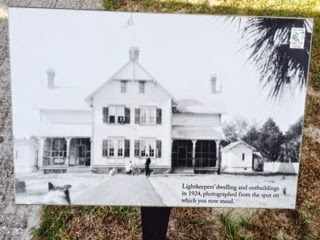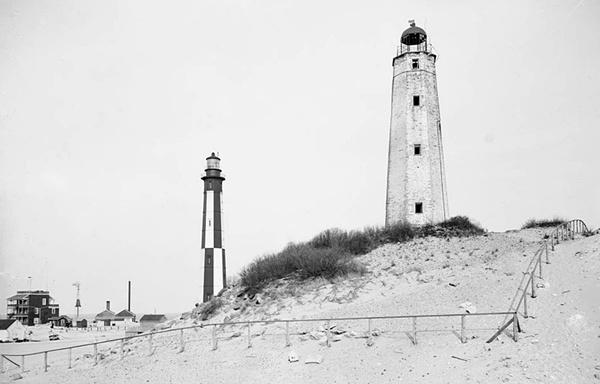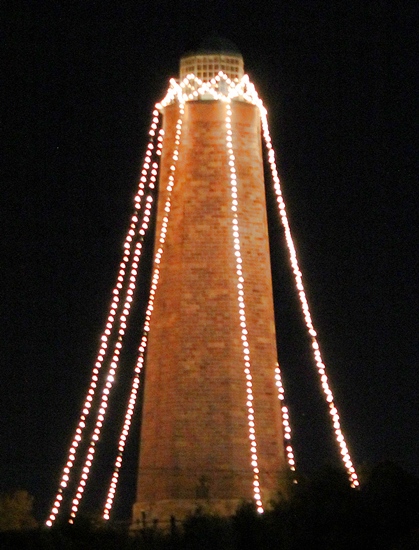This was a triple hit, a lighthouse, it had a historical marker, and is also listed on the National Register of Historical places....
A short ride to the site, then we went inside for a rather laborious lecture that lasted 45 minutes, as taught by the 80 plus something lady who's father and grandfather had been lighthouse keepers for 50 years between them.
After 45 minutes of a bad sound system, her loosing her place in her notes, and forgetting her train of thought, we did a short tour of the light, which was closed for access.
I did get a passport stamp for this location, but no pins postcards, or miniatures, there wasn't a shop.
Inscription. Standing at the highest point on the island, the Amelia Island Lighthouse was built from bricks re-used from the Cumberland Island Lighthouse in 1839 on land purchased from Mary Fernandez. The 67 foot tall lighthouse has walls four feet thick at the base tapering to two feet at the top. It is the only dual-wall construction lighthouse remaining from Florida's territorial period. First lit by whale oil, the light is now a third order Fresnel Lens made in Paris and visible 15 miles. This lighthouse is the oldest, still operational lighthouse in Florida and is the westernmost lighthouse on the east coast of the United States. The first keeper, Amos Latham, was a Corporal in the 1st Connecticut Regiment in the Revolution
Amelia Island is the northernmost barrier island on Florida’s Atlantic coast. The St. Mary’s River slowly empties into the Atlantic between Amelia Island and Georgia’s Cumberland Island to the north and serves as the curvaceous portion of the border between the neighboring states. Fernandina Beach is Amelia Island’s largest town, and it still seems locked in the enchantment and charm of the Victorian era. The island’s acres of marshlands add to the tranquil setting, but if you ask around a little you can quickly learn about the island’s scandalous past and just perhaps the unique origin of Amelia Island Lighthouse.
According to local lore, since the arrival of the Europeans, eight flags have flown over Amelia Island, giving rise to the title “Isle of 8 Flags.” Three of these flags were from the brief reigns of the “Patriots of Amelia Island,” Sir Gregor MacGregor, and a pirate, but for the most part, the island’s history can be summarized as “the French visited, the Spanish developed, the English named and the Americans tamed.” The island was named in honor of Princess Amelia Hanover, daughter of England’s King George II.
In 1802, a resolution of the Georgia General Assembly ceded jurisdiction of six acres on the southern tip of Cumberland Island to the U.S. Government for lighthouse purposes. At that time, this parcel was the southernmost site on the U.S. Atlantic coast, as Florida was back under Spanish rule, after the British left. It took eighteen years before Winslow Lewis built a lighthouse on Cumberland Island in 1820. In the interim, Congress had outlawed the importation of slaves in 1808. Given the proximity of Amelia Island to the Southern States, it soon became a major black market dealing in slaves and was home to scores of smugglers, drunkards, and prostitutes. The United States eventually stepped in and took control of the island in 1819, and in 1821 Spain officially ceded Florida to the United States.
Perhaps if the U.S. had gained control of Florida before construction of Cumberland Lighthouse, the tower might have been placed on Amelia Island. Instead, the lighthouse stood across the border, guiding vessels into St. Mary’s River and along the Atlantic Coast. Changes in the channel made it so the light on Cumberland Island could no longer be seen when entering the river, and on July 7, 1838, Congress provided $7,500 for relocating the tower. Cumberland Lighthouse was accordingly dismantled brick by brick, shipped across the river, and reconstructed atop the highest spot on Amelia Island.
The light source for the tower consisted of a collection of fourteen lamps, backed by reflectors, which revolved to produce a flashing characteristic. Though the tower is just sixty-four feet tall, the light has a focal plane of 107 feet thanks to the prominence on which it stands. Amos Latham followed the lighthouse across the river and served as its first keeper at its new location. The lighthouse was upgraded in 1856 with a third-order Fresnel lens. In 1858, a beacon light was established five-eighths of a mile seaward of the tower near Fort Clinch to form, with the lighthouse, a pair of range lights indicating the best channel across the bar. The beacon light was mounted on a car that could be rolled along a 100-foot-long tramway to track the changing channel.
David Levy Yull, who became Florida’s first Senator in 1845, led a push to build a cross-state railroad spanning the 155 miles between Fernandina Beach on the Atlantic and Cedar Keys on the Gulf. Completed in 1861, the railroad took eight years to build and allowed goods to be shipped between New York and New Orleans without having to round the Florida Keys with their dangerous reefs and shoals. Before the railroad could have much impact on the local economy, both it and the lighthouse were taken out of service by the Civil War.
Spared from wartime damage, the tower quickly returned to service after the conflict. One of the keepers in the post-war era was Dewayne W. Suydam, one of about twenty head keepers who, over the years, were responsible for climbing the tower’s sixty-nine granite steps to tend the light. Each keeper recorded the weather and other observations of interest in the station’s logbook. Keeper Suydam wrote an entry the day he gave up tobacco, and when he retired in 1891 at the age of sixty-three, he penned: “20 years ago I commenced in the Light House Service; have been absent but one night during that time” – talk about having no vacation time.
In 1881, a new, modern iron lantern room was installed atop the tower to replace the old one that was too small for the third-order lens. A temporary structure was built near the lighthouse, and a fourth-order flashing light was displayed from it between April 15 and July 1 while the new lantern room was put in place. The station's nine-by-eleven-foot, brick oil house was built in 1890 and could hold 450 five-gallon oil cans. A new third-order lens, manufactured in Paris by Barbier & Benard, was installed in the lighthouse on October 24, 1902, changing the light's characteristic from a white flash every ninety seconds to a flash every ten seconds. A red sector was added to the light in 1917 to alert mariners of dangerous shoals south of the tower in Nassau Sound.
The first dwelling for the keeper at Amelia Island Lighthouse was a very small brick house. This was replaced by a two-story residence that stood northwest of the tower. A third dwelling, a square, one story structure with a hipped roof, was built southeast of the lighthouse in 1886, but unfortunately none of these historic structures remain. In the early 1960s, the Coast Guard tore down the latest incarnation of the keeper's dwelling and replaced it with the present structure that is completely devoid of the charm possessed by the earlier dwellings.
Thomas P. O'Hagan retired as keeper of Amelia Island Lighthouse on June 30, 1925 at the age of sixty-six. He started his lighthouse career at Fort Ripley Shoal Lighthouse in Charleston, South Carolina, and later served at Georgetown Lighthouse and Ponce de Leon Inlet Lighthouse, before arriving at Amelia Island in 1905. Upon his retirement, the Lighthouse Service noted that he was “held in esteem by the officers in charge of the district.”
Electricity reached the tower in the 1930s, which allowed the station to be automated in 1970 and its final Coast Guard keeper, Otho. O Brown, to be reassigned. Following automation, the Coast Guard Auxiliary was responsible for the lighthouse and held CPR and boating safety classes at the station.
Under the National Historic Lighthouse Preservation Act of 2000, Amelia Island Lighthouse was declared surplus and offered to Fernandina Beach. In a ceremony held on March 28, 2001, the lighthouse was officially handed over to the city. In 2002, the city received a $350,000 grant from the Florida Division of Historical Resources, enabling Worth Contracting, Inc. to complete restoration work on the tower in 2004. During the project, the iron walkway around the lantern room was replaced along with at least one of the supporting brackets. At the time of my visit, the replaced pieces were being stored in the oil house, which has since be restored.
As the property is bordered by private homes, providing public access to the lighthouse is problematic. After weighing various options, the town decided to offer two “fee-based” public tours each month, wherein the participants will be bused to the site. The Coast Guard Auxiliary still maintains the lighthouse, which is the oldest standing lighthouse in Florida.
Head Keepers: Amos Latham (1838 – 1842), Capt. E. Richardson (1842 – 1848), George W. Walton (1848 – 1854), Horace Vaughan (1854 – 1857), James W. Woodland (1857 – 1859), Christopher C. Moore (1859), George Lightner (1859 – 1864), James Parker (1864 – 1868), Joseph H. Donnelly (1868 – 1873), Henry Swan (1873 – 1874), Henry Gage (1874 – 1878), Samuel Petty (1878 – 1879), Joseph S. Howell (1879 – 1880), Dewayne W. Suydam (1880 – 1891), Charles W. Grimm (1891 – 1905), Thomas Patrick O’Hagan (1905 – 1925), Thomas John O’Hagan (1925 – 1954).















































